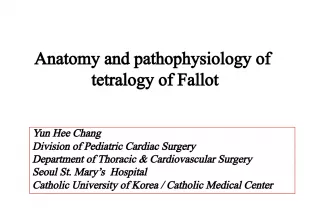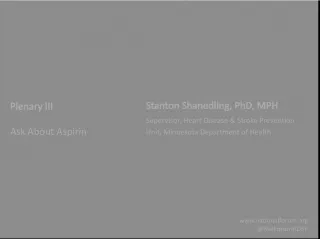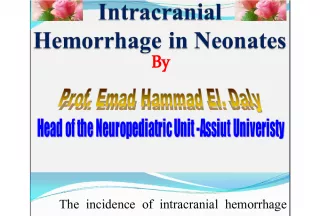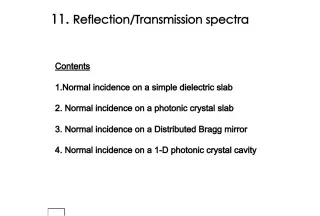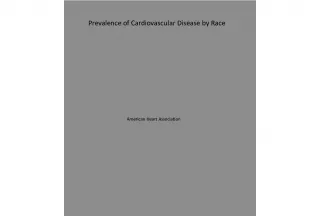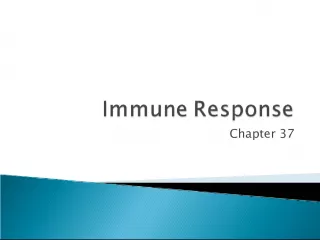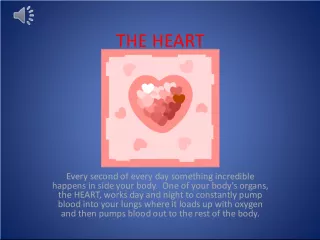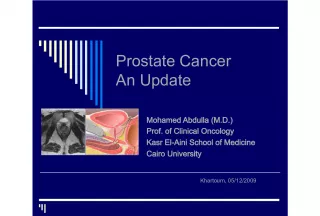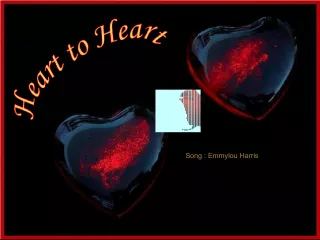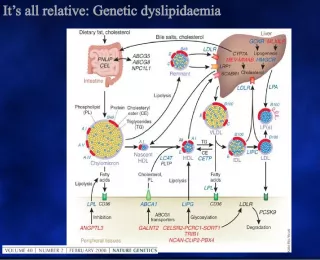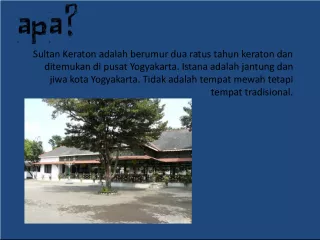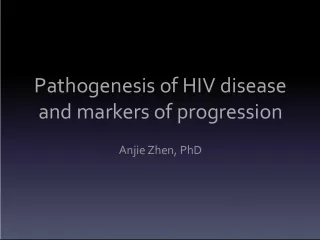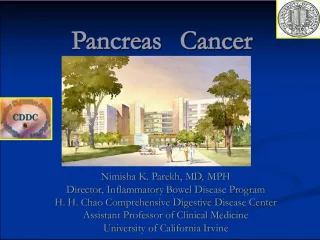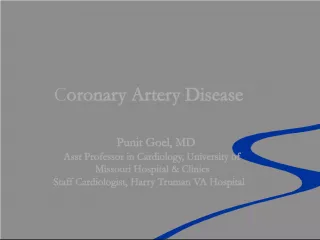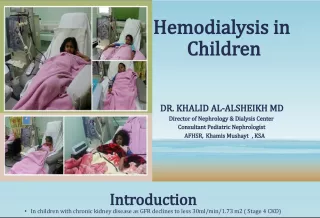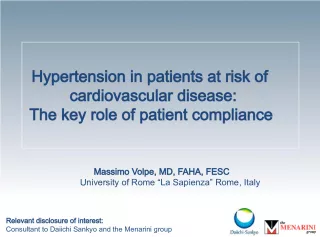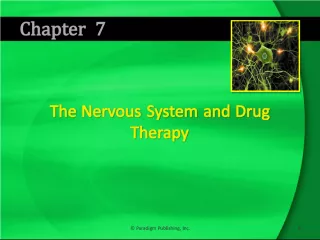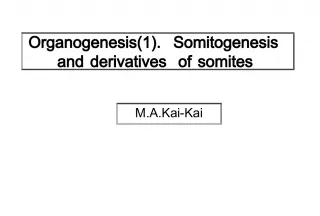Overview of Congenital Heart Disease Incidence and Types
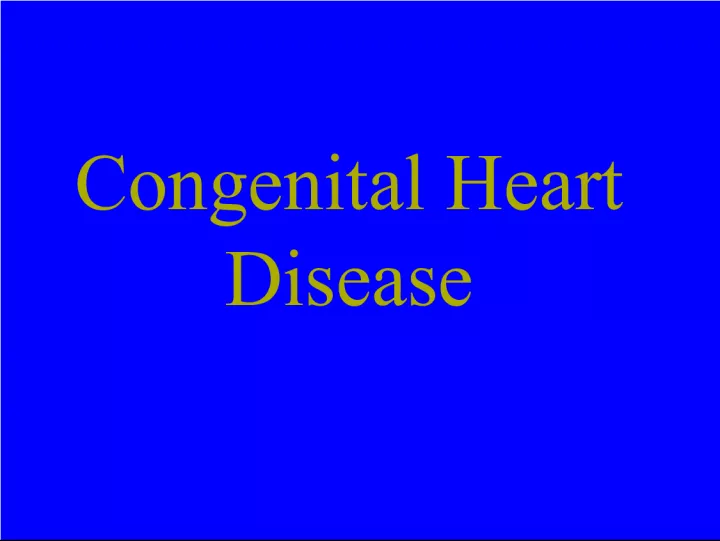

VSD is the most common CHD, while TOF is the most common cyanotic CHD. TGA is the most common cyanotic CHD requiring immediate surgical intervention.
- Uploaded on | 9 Views
-
 claudecurtis
claudecurtis
About Overview of Congenital Heart Disease Incidence and Types
PowerPoint presentation about 'Overview of Congenital Heart Disease Incidence and Types'. This presentation describes the topic on VSD is the most common CHD, while TOF is the most common cyanotic CHD. TGA is the most common cyanotic CHD requiring immediate surgical intervention.. The key topics included in this slideshow are . Download this presentation absolutely free.
Presentation Transcript
1. Congenital Heart Disease
2. Incidence of 1% in general population. VSD is most common CHD TOF is most common cyanotic CHD TGA is most common cyanotic CHD presenting in infancy Etiology: Multifactorial inheritance 90%. Chromosomal 5% Single mutant gene 3% Environmental 2% Incidence and Etiology
3. Presentations Asymptomatic heart murmer Cyanosis Congestive heart failure Syncope Shock
4. CHD in Chromosomal Aberrations Incidence Most common lesion Trisomy 21 50% VSD or A-V canal Trisomy 18 90+% VSD Trisomy 13 90% VSD XO Turner 35% CoA
5. CHD in Single Mutant Gene Syndromes Marfans Aortic aneurysm Noonans PS, ASD Williams Supravalvular AS Holt-Oram ASD, VSD NF PS, CoA
6. Teratogens and CHD Frequency Most common Alcohol 25-30% VSD Phenytoin 2-3% PS,AS,CoA,PDA Lithium 10% Ebstein Rubella 35% PPS, PDA Diabetes 3-5% Hypertrophic septum TGA, VSD, CoA (Incidence can be as high as 30-50% in poorly controlled DM) Lupus 50% 3rd degree heart block PKU 25-50% TOF, VSD, ASD
7. Presentations Asymptomatic (heart murmur) Small VSD, ASD Cyanosis D-TGA, TOF Congestive heart failure Large L-R shunt lesions Syncope AS, PS Shock Coarc, hypoplastic left heart
8. Birth 2w 8w 4m 1y 3-5y Adolescence VSD ASD| PDA CoA AS HLHS TOF TriA/S PA TGA TA TAPVR CHF CHF Shock Shock Shock P. HTN P. HTN Often asymptomatic Cyanosis CHF CHF CHF/syncope/murmur CHF/HTN Shock/Cyanosis Shock/Cyanosis Cyanosis Cyanosis/CHF Shock/Cyanosis HLHS=Hypoplastic left heart syndrome TriA/S=Tricuspid atresia CHF=Congestive heart failure P.HTN=Pulmonary hypertension FTT=Failure to thrive
9. Cyanotic CHD 1. Truncus Arteriosus 2. Transposition of the Great Arteries 3. Tricuspid Atresia 4. Tetralogy of Fallot 5. Total Anomalous Pulmonary Venous Return
10. Acyanotic CHD 1. VSD 2. ASD 3. PDA 4. Coarctation Aorta 5. Aortic Stenosis 6. Hypoplastic Left Heart
11. Cyanotic CHD with Decreased Pulmonary Blood Flow 1. Tetralogy of Fallot 2. Tricuspid Atresia 3. Total Anomalous Pulmonary Venous Return with obstruction
12. Cyanotic CHD with Increased Pulmonary Blood Flow 1. Transposition of the Great Arteries 2. Truncus Arteriosus 3. Total Anomalous Venous Return without obstruction
13. Acyanotic CHD with Increased Pulmonary Blood Flow (Volume Load) 1. ASD 2. VSD 3. PDA
14. Acyanotic CHD with Pulmonary Venous Congestion or Normal Blood Flow (Pressure Load) 1. Coarctation Aorta 2. Aortic Stenosis 3. Hypoplastic Left Heart 4. Pulmonary Stenosis
15. Circulation before birth
16. Circulation after birth
17. Cyanotic CHD with Decreased Pulmonary Blood Flow 1. Tetralogy of Fallot 2. Tricuspid Atresia
18. Tetralogy of Fallot 1. VSD 2. Pulmonary artery stenosis 3. Overriding aorta 4. Right ventricular hypertrophy
19. Tetralogy of Fallot Incidence of total CHD Age at presentation Clinical Auscultation Most common cyanotic CHD Usually by 6 months Cyanosis Cyanotic spells (squatting) Harsh systolic murmur Softer if worsening obstruction
20. Tetralogy of Fallot Radiology EKG Decreased pulmonary vascularity Boot-shaped heart R-sided aortic arch RAD, RAE, RVH
21. TOF treatment 1. For cyanotic spells: Knee-chest position Morphine sulfate Vasoconstrictors Propranolol 2. Iron for anemia 3. Surgical a. Palliation Blalock-Taussig Waterston shunt Potts operation b. Corrective at 1-5 years of age
23. Tetralogy of Fallot
24. Tetralogy of Fallot
25. Tricuspid Atresia 1. Normally related great arteries (69%) With small VSD and PS (most common). Intact septum with pulmonary atresia Large VSD without PS 2. D-transposition of great arteries (28%) 3. L-transposition of great arteries (4%) Types
26. Tricuspid Atresia Incidence: Age at presentation Clinical No obstruction pulmonary blood flow Obstruction pulmonary blood flow Rare Infancy, depending on pulmonary blood flow Congestive heart failure Similar to VSD Cyanosis Variable More intense cyanosis as ductus closes
27. Tricuspid Atresia Auscultation: Systolic murmur with single S2 Radiology: Variable Decreased pulmonary vasculature
28. Treatment Tricuspid Atresia 1. PGE1 to keep ductus open 2. Balloon septostomy if no VSD 3. Surgical a. Palliation systemic-pulmonary shunt (PS) pulmonary artery banding (large VSD) b. Corrective Fontan
30. Cyanotic CHD with Increased Pulmonary Blood Flow 1. Truncus Arteriosus 2. Transposition of the Great Arteries 3. Total Anomalous Pulmonary Venous Return
31. Truncus Arteriosus Incidence Age at presentation Clinical Auscultation Pulmonary vasculature EKG Rare Neonatal Cyanosis Signs of CHF Wide pule pressure and bounding arterial pulses Harsh systolic murmur Increased BVH or RVH
32. Truncus Arteriosus Associations Treatment Right sided aortic arch Thymic aplasia - DiGeorge Syndrome Medical Pulmonary artery bending Rastellis operation
34. Truncus Arteriosus
35. Transposition of the Great Vessels D-type D-transposition, complete transposition, most common form -Aorta arises from the right ventricle. -Pulmonary artery arises from the left ventricle. -PDA is the only connection between systemic and pulmonary circulations, although VSD in 40%.
36. Transposition of the Great Vessels L-type L-transposition, also called corrected transposition -Both ventricles and great vessels are transposed
37. D-TGA Incidence Age presentation Clinical Auscultation Radiology EKG 8% of all CHD Male:female 2:1 Newborn, when ductus closes Cyanosis within 1st 48 hrs if no VSD CHF when large left to right shunts Loud single S2, no murmur Egg-on-a-string heart Increased pulmonary vasculature, depending on size shunt RVH
38. Treatment for D-TGA 1. Prostaglandin E 2. Surgical a. Atrial septostomy if no VSD (Rashkind, Blalock - Hanlon etc.) b. Anatomical correction (Jatenes operation)
40. TGA
41. TAPVR types 1. Supracardiac emptying in the left vertical vein (most common type 80-90%) which subsequently drains into the SVC 2. Cardiac emptying into the coronary sinus or right atrium 3.Infradiaphragmatic emptying into vertical vein that descends through diaphragm into portal vein and or IVC
42. TAPVR Incidence Age at presentation Clinical findings EKG Radiology 2% Newborn Rapid cyanosis in the infra- diaphragmatic type Non-obstructive similar to ASD plus mild cyanosis RVH Snowman configuration Diffuse reticular opacities Looks like HMD without air bronchograms!
43. TAPVR Associations Treatment Polysplenia Asplenia (3/4 patients also TAPVR) Surgical ligation of anomalous vein
45. Total anomalous venous return
46. Acyanotic CHD with Increased Pulmonary Blood Flow (left to right shunt lesions) 1. ASD 2. VSD 3. PDA
47. ASD Incidence Types Age presentation Clinical Auscultation EKG Treatment 10% CHD Ostium secundum (most common) Sinus venosus defect Ostium primum (AV canal) Varies Mostly asymptomatic Slender body build Widely split and fixed S2! + SEM RAD and RVH No SBE coverage needed ! Surgery for large shunts
50. ASD
51. VSD Incidence Types Age presentation Most common CHD (20%) Coexists with other lesions in 5% Membranous (80%) Muscular (10%) Large - at age 2-3 months with congestive failure Small to moderate - usually asymptomatic
52. VSD Clinical Auscultation Congestive heart failure if large Poor weight gain Systolic thrill with holosystolic murmur at LLSB Diastolic murmur with large shunts and loud P2 with pulmonary hypertension Diastolic rumble at apex indicates CHF
53. VSD EKG Radiology Associations Complications 1. normal if small VSD 2. LAE-LVH if moderate 3. LAE-BVH if large 4. RVH-PVOD Increased vascularity with larger shunts and enlargement cardiac size Holt-Oram syndrome, Downs, Trisomy 13, Trisomy 18 Eisenmengers Syndrome (shunt reverses to right left)
54. Treatment VSD 1. Spontaneous closure of small VSDs 2. Medical therapy (diuretics, digitalis) 3. Pulmonary artery banding 4. Surgical placement of patch over VSD 5. SBE prophylaxis
56. VSD
57. PDA Clinical Premature infants - Congestive heart failure Term infants - usually asymp murmur Pulm. Vasculature Increased Radiology Dependent on size of shunt Left atrial enlargement often present Massive bulge at left upper mediastinum in large shunts Treatment Premature infants - Indomethacin Ligation and division of the ductus Prostaglandin E infusion maintains ductal patency when needed
59. PDA
60. Acyanotic CHD with Pulmonary Venous Congestion or Normal Blood Flow (Pressure Load) 1. Coarctation Aorta 2. Aortic Stenosis 3. Hypoplastic Left Heart 4. Pulmonary Stenosis
61. Coarctation of the Aorta Incidence: 5% of CHD Clinical: Preductal or infantile type presents in young child with CHF and LE pulses Adult type presents with hypertension and difference in arm and leg pulses Radiology: Rib notching - starts age 6-8 Associations : Often isolated Turners, NF, Williams, Sturge-Weber Treatment: Primary repair Prostaglandin E to infants
64. Rib notching
65. Aortic Stenosis Clinical: Most asymptomatic Angina Syncope - may be fatal Pulm. Vasc.: Normal Associations: Williams Syndrome Treatment: Medical Surgical No high impact sports
66. Hypoplastic Left Heart Incidence: 8% of all CHD, most common cause for early cardiac death Age at present.: Immediately at birth or first weeks Clinical: 1st presentation is usually not cyanosis, but signs of shock Pulm. Vasc.: Increased Radiology: Large cardiac silhouette Treatment: Prostaglandin E Norwood procedure (high mortality)
68. Mitral Valve Prolapse Facts More common in girls May be inherited as autosomal dominant trait with variable expression Common in Marfans Dominant signs are ausculatory; late systolic apical murmur preceded by a click PVCs may be a complication Non progressive in children Endocarditis prophylaxis indicated only in substantiated cases, usually those with mitral insufficiencies
69. Blalock-Taussig shunt. The subclavian artery is transected and anastomosed in a end-to-side fashion to the ipsilateral pulmonary artery. Usually the subclavian artery opposite to the arch is used.
70. The Modified Blalock-Taussig shunt now uses a Goretex graft (green) to connect the subclavian artery to the pulmonary artery. This preserves the subclavian artery .
71. Potts shunt is where a side-to-side anastomosis is made between the descending aorta and the pulmonary artery.
72. The Waterston-Cooley shunt is similar to the Potts shunt. A side to side anastomosis or window is created between the pulmonary artery and the ascending aorta. The difference is that it is the ascending aorta (Waterston-Cooley) rather than the descending aorta which is anastomosed to the pulmonary artery (Potts).
75. Pearls Bounding pulses; think PDA or AV fistula. Widely fixed split second heart tone; think ASD. No pre- and postductal saturation differences when there is total mixing of deoxygenated venous blood with oxygenated pulmonary blood in the heart; such as -total anomalous pulmonary venous return -truncus arteriosus
76. Pearls Pre- and post-ductal saturation differences post-ductal saturation is higher in TGA all other congenital heart anomalies without total mixing in the heart have a lower post- ductal saturation
